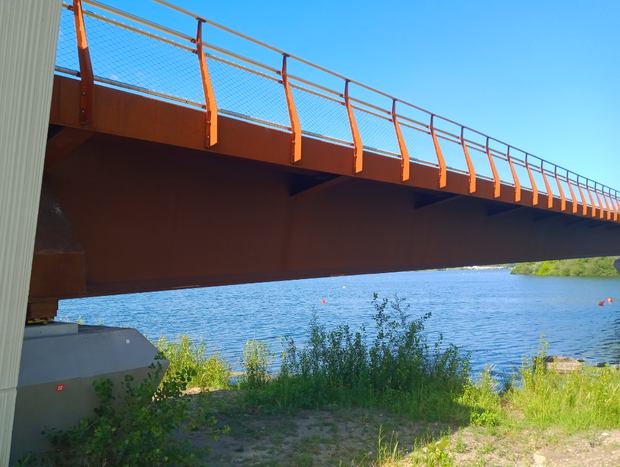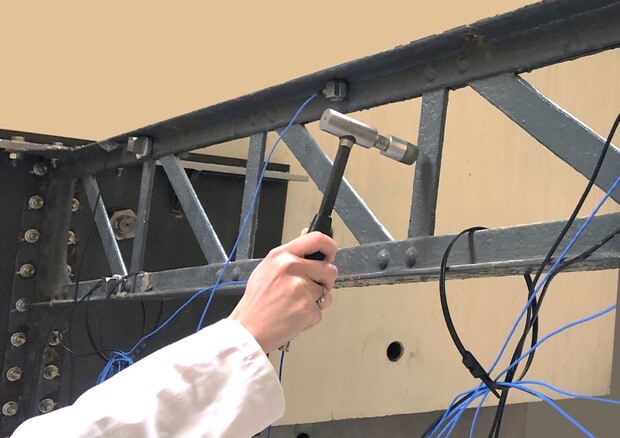Metal Structures and Their Assemblies
This scientific axis is dedicated to improving knowledge related to the behavior and durability of metal structures and their assemblies, whether they are welded or riveted. The activities involved may concern new structures in the case of the use of new metal materials or old structures. In France, many metal structures used in civil engineering works (metal or mixed bridges) or in buildings have indeed reached several decades and require re-evaluation work, and sometimes adaptation to new constraints.

Weathering steels use
Weathering steels are structural steels that are similar to conventional steels but whose chemical composition gives them improved resistance to atmospheric corrosion, allowing them to be used in a bare state. This characteristic is beneficial with regard to the three axes of sustainable development due to the absence of (re)painting: maintenance costs, VOC emissions, waste production or inconvenience to users are drastically reduced.
The SMC laboratory is involved in research and support for public policies related to weathering steels. Research focuses particularly on the evaluation and prediction of the performance of these steels used in the structures of civil engineering works and electrical networks. These studies help to better understand this material and to evolve towards good practices. SMC has thus carried out the revision of the UGE-Cerema National recommendations for the use of weathering steels in civil engineering works.

Assessment of riveted steel structures (CIFRE SNCF-AREP Thesis , Hannah Franz – 2021-2024)
As part of the renovation of 19th-century steel structures, reassessment of their structural performance is often necessary to ensure safety and durability. The project focuses on the lattice girders of train station roofs, platform shelters, market halls, etc. Many uncertainties exist regarding the modeling of these structures, particularly their riveted connections. The project aims at improving the understanding of the behavior of riveted connections and their influence on the overall behavior of lattice girders in order to better assess the structural performance of riveted lattice girders.
With the expertise of the SMC laboratory in structural monitoring and modeling, experimental campaigns have been carried out on riveted lattice girders recovered from a demolition site. One beam was instrumented with accelerometers to perform an experimental modal analysis. Another beam was equipped with strain gauges, an optical fiber, and lasers to conduct quasi-static tests and measure displacements and stresses. The experimental results are used to adjust finite element models and characterize the riveted connections.

REANIM Project - Improving the service life of welded assemblies
Welding technology has been widely used over the past 30 years to assemble metal structures in various fields (naval, civil engineering, etc.). However, the fusion welding process generates local internal stresses and geometric irregularities due to changes in the materials' phases during the welding and cooling process of the assembly. The created internal tensile stresses are the most damaging as they reduce fatigue life, while those in compression are more likely to have a beneficial effect on fatigue.
There are a number of techniques (shot peening, hammering, TIG, etc.) to extend the fatigue life of these assemblies by modifying their stress state and/or improving the weld bead geometry. These techniques are currently used in industry for new welded elements. It would be interesting to consider rehabilitating existing structures with respect to fatigue. To do this, it would be necessary to provide quantitative methods to assess the effectiveness of these treatments. The objective of this study is therefore to numerically and experimentally evaluate the effects of shot peening on the stress state at the root of the weld bead and on the fatigue life.
The SMC laboratory is actively working on the experimental study and modeling of welding and surface treatment processes in collaboration with several partners, including Meliad, MIC (a subsidiary of Curtiss-Wright), and SONATS (a subsidiary of Europe Technologies) for shot peening and ultrasonic hammering processes and the measurement of residual stresses in welded assemblies.